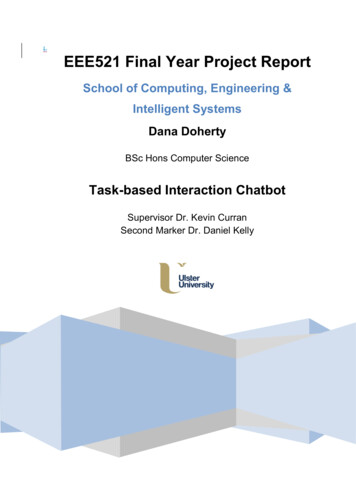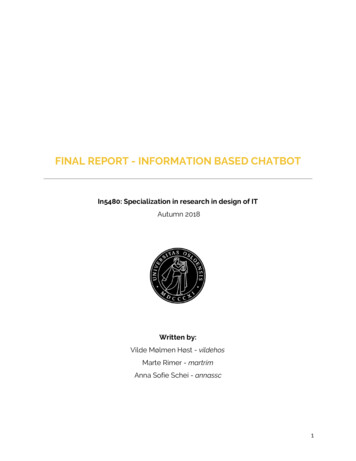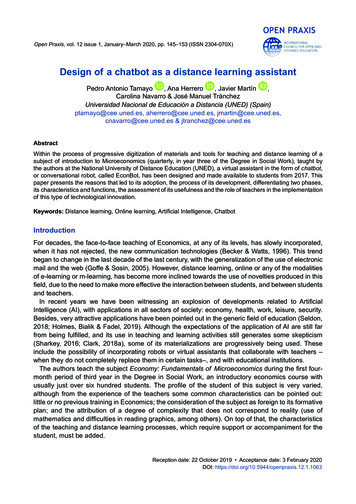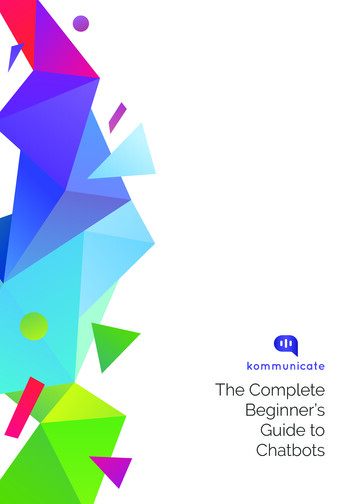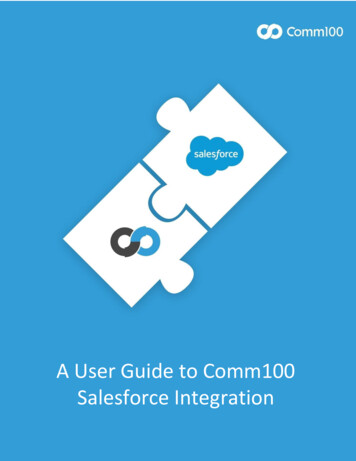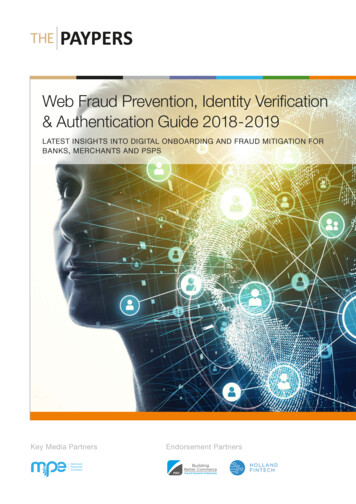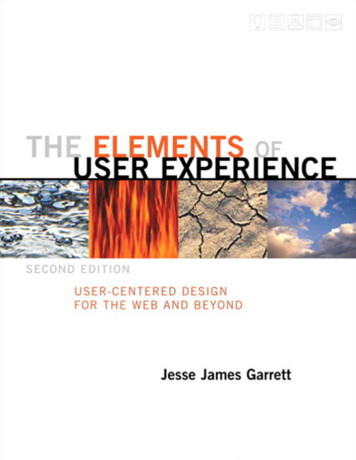
Transcription
JMIR MEDICAL INFORMATICSte Pas et alOriginal PaperUser Experience of a Chatbot Questionnaire Versus a RegularComputer Questionnaire: Prospective Comparative StudyMariska E te Pas1, MD; Werner G M M Rutten2, PhD; R Arthur Bouwman1,3, MD, PhD; Marc P Buise1, MD, PhD1Anesthesiology Department, Catharina Hospital, Eindhoven, Netherlands2Game Solutions Lab, Eindhoven, Netherlands3Department of Electrical Engineering, Eindhoven University of Technology, Eindhoven, NetherlandsCorresponding Author:Mariska E te Pas, MDAnesthesiology DepartmentCatharina HospitalMichelangelolaan 2Eindhoven, 5623 EJNetherlandsPhone: 31 627624857Email: ound: Respondent engagement of questionnaires in health care is fundamental to ensure adequate response rates for theevaluation of services and quality of care. Conventional survey designs are often perceived as dull and unengaging, resulting innegative respondent behavior. It is necessary to make completing a questionnaire attractive and motivating.Objective: The aim of this study is to compare the user experience of a chatbot questionnaire, which mimics intelligentconversation, with a regular computer questionnaire.Methods: The research took place at the preoperative outpatient clinic. Patients completed both the standard computerquestionnaire and the new chatbot questionnaire. Afterward, patients gave their feedback on both questionnaires by the UserExperience Questionnaire, which consists of 26 terms to score.Results: The mean age of the 40 included patients (25 [63%] women) was 49 (SD 18-79) years; 46.73% (486/1040) of all termswere scored positive for the chatbot. Patients preferred the computer for 7.98% (83/1040) of the terms and for 47.88% (498/1040)of the terms there were no differences. Completion (mean time) of the computer questionnaire took 9.00 minutes by men (SD2.72) and 7.72 minutes by women (SD 2.60; P .148). For the chatbot, completion by men took 8.33 minutes (SD 2.99) and bywomen 7.36 minutes (SD 2.61; P .287).Conclusions: Patients preferred the chatbot questionnaire over the computer questionnaire. Time to completion of bothquestionnaires did not differ, though the chatbot questionnaire on a tablet felt more rapid compared to the computer questionnaire.This is an important finding because it could lead to higher response rates and to qualitatively better responses in futurequestionnaires.(JMIR Med Inform 2020;8(12):e21982) doi: 10.2196/21982KEYWORDSchatbot; user experience; questionnaires; response rates; value-based health careIntroductionQuestionnaires are routinely used in health care to obtaininformation from patients. Patients complete thesequestionnaires before and after a treatment, an intervention, ora hospital admission. Questionnaires are an important tool whichprovides patients the opportunity to voice their experience in asafe fashion. In turn, health care providers gather 2/XSL FORenderXthat cannot be picked up in a physical examination. Throughthe use of patient-reported outcome measures (PROMs), thepatient’s own perception is recorded, quantified, and comparedto normative data in a large variety of domains such as qualityof life, daily functioning, symptoms, and other aspects of theirhealth and well-being [1,2]. To enable the usage of datadelivered by the PROMs for the evaluation of services, qualityJMIR Med Inform 2020 vol. 8 iss. 12 e21982 p. 1(page number not for citation purposes)
JMIR MEDICAL INFORMATICSte Pas et alof care, and also outcome for value-based health care correctly,respondent engagement is fundamental [3].MethodsSubsequently, adequate response rates are needed forgeneralization of results. This implies that maximum responserates from questionnaires are desirable in order to ensure robustdata. However, recent literature suggests that response rates ofthese PROMs are decreasing [4,5].RecruitmentFrom previous studies, it is clear that factors which increaseresponse rates include short questionnaires, incentives,personalization of questionnaires as well as repeat mailingstrategies or telephone reminders [6-9]. Additionally, it seemsthat the design of the survey has an effect on response rates.Conventional survey designs are often perceived as dull andunengaging, resulting in negative respondent behavior such asspeeding, random responding, premature termination, and lackof attention. An alternative to conventional survey designs ischatbots with implemented elements of gamification, which isdefined as the application of game-design elements and gameprinciples in nongame contexts [10].A chatbot is a software application that can mimic intelligentconversation [11]. The assumption is that by bringing more funand elements of gamification in a questionnaire, response rateswill subsequently rise.In a study comparing a web survey with a chatbot survey theconclusion was that the chatbot survey resulted in higher-qualitydata [12]. Patients may also feel that chatbots are saferinteraction partners than human physicians and are willing todisclose more medical information and report more symptomsto chatbots [13,14].In mental health, chatbots are already emerging as useful toolsto provide psychological support to young adults undergoingcancer treatment [15]. However, literature investigating theeffectiveness and acceptability of chatbot surveys in health careis limited. Because a chatbot is suitable to meet theaforementioned criteria to improve response rates ofquestionnaires, this prospective preliminary study will focus onthe usage of a chatbot [13,16]. The aim of this study is tomeasure the user experience of a chatbot-based questionnaireat the preoperative outpatient clinic of the AnesthesiologyDepartment (Catharina Hospital) in comparison with a regularcomputer 1982/XSL FORenderXAll patients scheduled for an operation who visit the outpatientclinic of the Anesthesiology Department (Catharina Hospital)complete a questionnaire about their health status. Afterwardthere is a preoperative intake consultation with a nurse or adoctor regarding the surgery, anesthesia, and risks related totheir health status. The Medical Ethics Committee and theappropriate Institutional Review Board approved this study andthe requirement for written informed consent was waived bythe Institutional Review Board.We performed a preliminary prospective cohort study andincluded 40 patients who visited the outpatient clinic betweenSeptember 1, 2019, and October 31, 2019. Because of the lackof previous research on this topic and this is a preliminary study,we discussed the sample size (N 40) with the statistician of ourhospital and this was determined to be clinically sufficient.Almost all patients could participate in the study. The exclusioncriteria included patients under the age of 18, unable to speakDutch, and those who were illiterate.Patients were asked to participate in the study and were providedwith information about the study if willing to participate. Afterpermission for participation was obtained from the patient, theresearcher administered the questionnaires. As mentioned above,informed consent was not required as patients were anonymousand no medical data were analyzed.The Two QuestionnairesThe computer questionnaire is the standard method at theAnesthesiology Outpatient Department (Figure 1). Wedeveloped a chatbot questionnaire (Figure 2) with identicalquestions to the computer version. This ensured that thequestionnaires were of the same length, avoiding bias due toincreased or decreased appreciation per question. The patientscompleted both the standard and chatbot questionnaires, as thestandard computer questionnaire was required as part of thepreoperative system in the hospital. Patients started alternatelywith either the chatbot or the computer questionnaire, in orderto prevent bias in length of time and user experience. Duringthe completion of both questionnaires, time required to completewas documented.JMIR Med Inform 2020 vol. 8 iss. 12 e21982 p. 2(page number not for citation purposes)
JMIR MEDICAL INFORMATICSte Pas et alFigure 1. Computer 1982/XSL FORenderXJMIR Med Inform 2020 vol. 8 iss. 12 e21982 p. 3(page number not for citation purposes)
JMIR MEDICAL INFORMATICSte Pas et alFigure 2. Chatbot questionnaire.The User Experience QuestionnaireAfter completion of both questionnaires, patients providedfeedback about the user experience. Patients were asked to ratetheir experience by providing scores for both questionnaireswith the User Experience Questionnaire (UEQ; Figure 3). Thereliability and validity of the UEQ scales were investigated in11 usability tests which showed a sufficiently high 2/XSL FORenderXof the scales measured by Cronbach α [17-19]. Twenty-sixterms were shown on a tablet and for each term patients gavetheir opinion by dragging the button to the “chatbot side” or tothe “computer side.” They could choose to give 1, 2, 3, or 4points to either the computer or the chatbot in relation to aspecific term. If, according to the patient, there was no differencebetween the computer and the chatbot, he or she let the buttonin the middle of the bar.JMIR Med Inform 2020 vol. 8 iss. 12 e21982 p. 4(page number not for citation purposes)
JMIR MEDICAL INFORMATICSte Pas et alFigure 3. User Experience Questionnaire.The UEQ tested the following terms: pleasant, understandable,creative, easy to learn, valuable, annoying, interesting,predictable, rapid, original, obstructing, good, complex,repellent, new, unpleasant, familiar, motivating, as expected,efficient, clear, practical, messy, attractive, kind, and innovative.As much as 20 of the 26 items were positive terms, such as“pleasant.” The other 6 are negative terms, such as “annoying.”Outcome MeasuresThe primary outcome measure of this research is the userexperience score and the difference in score between thestandard computer questionnaire and the chatbot questionnaire.Secondary outcome was duration to complete a questionnaire.Statistical AnalysisData analysis primarily consisted of descriptive statistics andoutcomes were mainly described in percentages or proportions.The unpaired t test was used to quantify significant differencesbetween men and women and for time differences, because thehttp://medinform.jmir.org/2020/12/e21982/XSL FORenderXdata were normally distributed. A P value of .05 or less waschosen for statistical significance. Data were analyzed withSPSS statistics version 25 (IBM). Microsoft Excel version 16.1was used for graphics.This manuscript adheres to the applicable TREND guidelines[20].ResultsThe mean age of the 40 patients included, of whom 25 (63%)were women, was 49 (SD 18-79) years.The average score per term was calculated and shown in Figure4. The UEQ scores showed that patients favored the chatbotover the standard questionnaire. According to the graph, thepatients prefer the chatbot for 20 of the 26 terms (77%), all ofwhich are positive terms. The average values for the other 6terms, which are the negative terms (23%), are shown to haveJMIR Med Inform 2020 vol. 8 iss. 12 e21982 p. 5(page number not for citation purposes)
JMIR MEDICAL INFORMATICSa negative value. This indicates that on average the patientste Pas et alassociated the standard questionnaire with negative terms.Figure 4. Average User Experience Questionnaire (UEQ) scores per term and standard deviation. A score above 0 illustrates that the term fits bestwith the chatbot. A score below 0 illustrates that the term fits best with the computer.In total, 1040 terms were scored. As much as 46.73% (n 486)of the user experience terms were scored positive for the chatbot,47.88% (n 498) of the terms had preference neither for chatbotnor computer, and for 7.98% (n 83) of the terms patientspreferred the computer.Average time to completion of the computer questionnaire was8.20 (SD 2.69) minutes; for the chatbot questionnaire this was7.72 (SD 2.76) minutes. The questionnaire completed XSL FORenderXtook on average more time to complete, as the data in Table 1indicate.Time to completion differed between men and women, but didnot reach statistical significance. Every patient completed thesecond questionnaire statistically significantly faster than theinitial one (chatbot P .044, computer P .012), irrespective ofwhich questionnaire was completed initially (Table 1).JMIR Med Inform 2020 vol. 8 iss. 12 e21982 p. 6(page number not for citation purposes)
JMIR MEDICAL INFORMATICSte Pas et alTable 1. Time to completion (minutes).CriteriaComputer questionnaire completiontime (minutes), mean (SD)Chatbot questionnaire completion time(minutes), mean (SD)8.20 (2.6)7.72 (2.7)Men9.00 (2.7)8.33 (2.9)Women7.72 (2.6)7.36 (2.6)P value.148.287Computer first9.25 (2.4)6.85 (2.1)Chatbot first7.15 (2.6)8.60 (3.0)P value.012.044Average time to completion of computer- and chatbot-basedquestionnaire (n 40)All patientsAverage time to completion for men (n 15) versus women (n 25)Average time to completion depending on computer first (n 20)or chatbot first (n 20)DiscussionPrincipal FindingsIn this prospective observational study, we evaluated the userexperience of a chatbot questionnaire and compared it to astandard computer questionnaire in an anesthesiology outpatientsetting. Our results demonstrate that patients favored the chatbotquestionnaire over the standard computer questionnaireaccording to the UEQ, which is in line with the previousresearch by Jain et al [21], who showed that users preferredchatbots as these provide a “human-like” natural languageconversation.Another intriguing result, as seen in Figure 4, is that the highestscore to the chatbot was given for “rapid.” However, the timeto completion of the questionnaires did not differ between thecomputer questionnaire and the chatbot questionnaire. Thisindicates that a questionnaire answered on a tablet may give theperception of being faster than a standard model answered ona computer. In addition, by using more capabilities of a chatbotit is possible to shorten the questionnaire, possibly leading tohigher response rates, as mentioned by Nakash et al [6].The second questionnaire took significantly less time tocomplete than the initial one, as the contents are identicalbetween the 2 questionnaires. This is not an unexpectedobservation. Although time to completion of the initialquestionnaire was significantly different compared to that ofthe second questionnaire, bias in the results was minimized byalternating the order of questionnaires.Comparison With Prior WorkExplanations for low response rates can be disinterest, lack oftime, or inability to comprehend the questions. Furthermore,patient characteristics such as age, social economic status,relationship status, and those with preoperative comorbiditiesappear to have a negative influence on response rates, with themajority being nonmodifiable factors [22]. However, Ho et al[23] demonstrated that the method employed to invite andinform patients of the PROM collection, and the 2/XSL FORenderXin which it is undertaken, significantly alters the response ratein the completion of PROMs. This means that, as expected inthis study, there is a chance that response rates will rise by usinga chatbot instead of a standard questionnaire.GamificationAs described in the study by Edwards et al [7], response rateswill rise when incentives are used. Currently, questionnairesare often lacking elements motivating the patient to completethem. The introduction of nudging techniques, such asgamification, can help. Nudging is the subtle stimulation ofsomeone to do something in a way that is gentle rather thanforceful or direct, based on insights from behavioral psychology[24,25]. In a recent study by Warnock et al [26], where thestrong positive impact of gamification on survey completionwas demonstrated, respondents spent 20% more time ongamified questions than on questions without a gamified aspect,suggesting they gave thoughtful responses [26]. Gamificationhas been proposed to make online surveys more pleasant tocomplete and, consequently, to improve the quality of surveyresults [27,28].LimitationsThere are some limitations to this research. First, as mentionedin the “Introduction” section, a chatbot can mimic intelligentconversation and is a form of gamification. In our study we hadidentical questionnaires and therefore did not explore how thechatbot could mimic intelligent conversation. However, thisresearch demonstrates that only minor changes in thequestionnaire’s design lead to improved user experience.Second, because both the tablet and the chatbot were differentfrom the standard computer questionnaire, it is possible that theuser experience was influenced by the use of a tablet rather thanby the characteristics of a chatbot solely. Third, although theUEQ shows us that the patients appreciated the chatbot morethan the computer, we did not use qualitative methods tounderstand what factors drove users to identify the chatbot asa more positive experience. Fourth, although we recommendthe use of a chatbot in the health care setting to improveJMIR Med Inform 2020 vol. 8 iss. 12 e21982 p. 7(page number not for citation purposes)
JMIR MEDICAL INFORMATICSte Pas et alquestionnaire response rate as seen in previous literature, wedid not formally investigate this outcome.have beneficial effects such as higher response rates and higherquality of the answers as well.Future ResearchConclusionsBecause patients preferred the chatbot questionnaire over thecomputer questionnaire, we expect that a chatbot questionnairecan result in higher response rates. This research is performedas a first step in the development of a tool by which we canachieve adequate response rates in questionnaires such as thePROMs. Further research is needed, however, to investigatewhether response rates of a questionnaire will rise due toalteration of the design. In future research it will be interestingto investigate which elements of gamification are needed toPatients preferred the chatbot questionnaire over theconservative computer questionnaire. Time to completion ofboth questionnaires did not differ, though the chatbotquestionnaire on a tablet felt more rapid compared to thecomputer questionnaire. Possibly, a gamified chatbotquestionnaire could lead to higher response rates and toqualitatively better responses. The latter is important whenoutcomes are used for the evaluation of services, quality of care,and also outcome for value-based health care.Authors' ContributionsAll authors contributed to the study conception and design. Material preparation, data collection, and analysis were performedby MP and WR. The first draft of the manuscript was written by MP and all authors commented on previous versions of themanuscript. All authors read and approved the final manuscript.Conflicts of InterestNone ustralian Commission on Safety and Quality in Health Care. URL: utcome-measures [accessed 2020-11-06]Baumhauer JF, Bozic KJ. Value-based Healthcare: Patient-reported Outcomes in Clinical Decision Making. Clin OrthopRelat Res 2016 Jun;474(6):1375-1378. [doi: 10.1007/s11999-016-4813-4] [Medline: 27052020]Gibbons E, Black N, Fallowfield L, Newhouse R, Fitzpatrick R. Essay 4: Patient-reported outcome measures and theevaluation of services. In: Raine R, Fitzpatrick R, Barratt H, Bevan G, Black N, Boaden R, et al, editors. Challenges,Solutions and Future Directions in the Evaluation of Service Innovations in Health Care and Public Health. Southampton,UK: NIHR Journals Library; May 2016.Hazell ML, Morris JA, Linehan MF, Frank PI, Frank TL. Factors influencing the response to postal questionnaire surveysabout respiratory symptoms. Prim Care Respir J 2009 Sep;18(3):165-170 [FREE Full text] [doi: 10.3132/pcrj.2009.00001][Medline: 19104738]Peters M, Crocker H, Jenkinson C, Doll H, Fitzpatrick R. The routine collection of patient-reported outcome measures(PROMs) for long-term conditions in primary care: a cohort survey. BMJ Open 2014 Feb 21;4(2):e003968 [FREE Fulltext] [doi: 10.1136/bmjopen-2013-003968] [Medline: 24561495]Nakash RA, Hutton JL, Jørstad-Stein EC, Gates S, Lamb SE. Maximising response to postal questionnaires--a systematicreview of randomised trials in health research. BMC Med Res Methodol 2006 Feb 23;6:5 [FREE Full text] [doi:10.1186/1471-2288-6-5] [Medline: 16504090]Edwards P, Roberts I, Clarke M, DiGuiseppi C, Pratap S, Wentz R, et al. Methods to increase response rates to postalquestionnaires. Cochrane Database Syst Rev 2007 Apr 18(2):MR000008. [doi: 10.1002/14651858.MR000008.pub3][Medline: 17443629]Toepoel V, Lugtig P. Modularization in an Era of Mobile Web. Social Science Computer Review 2018 Jul:089443931878488.[doi: 10.1177/0894439318784882]Sahlqvist S, Song Y, Bull F, Adams E, Preston J, Ogilvie D, iConnect Consortium. Effect of questionnaire length,personalisation and reminder type on response rate to a complex postal survey: randomised controlled trial. BMC Med ResMethodol 2011 May 06;11:62 [FREE Full text] [doi: 10.1186/1471-2288-11-62] [Medline: 21548947]Robson K, Plangger K, Kietzmann JH, McCarthy I, Pitt L. Is it all a game? Understanding the principles of gamification.Business Horizons 2015 Jul;58(4):411-420. [doi: 10.1016/j.bushor.2015.03.006]A. S, John D. Survey on Chatbot Design Techniques in Speech Conversation Systems. ijacsa 2015;6(7). [doi:10.14569/ijacsa.2015.060712]Kim S, Lee J, Gweon G. Comparing Data from Chatbot and Web Surveys: Effects of Platform and Conversational Styleon Survey Response Quality. In: CHI '19: Proceedings of the 2019 CHI Conference on Human Factors in ComputingSystems. New York, NY: ACM Press; Sep 04, 2019:1-12.Palanica A, Flaschner P, Thommandram A, Li M, Fossat Y. Physicians' Perceptions of Chatbots in Health Care:Cross-Sectional Web-Based Survey. J Med Internet Res 2019 Apr 05;21(4):e12887. [doi: 10.2196/12887] 2/e21982/XSL FORenderXJMIR Med Inform 2020 vol. 8 iss. 12 e21982 p. 8(page number not for citation purposes)
JMIR MEDICAL 27.28.te Pas et alNadarzynski T, Miles O, Cowie A, Ridge D. Acceptability of artificial intelligence (AI)-led chatbot services in healthcare:A mixed-methods study. Digit Health 2019;5:2055207619871808 [FREE Full text] [doi: 10.1177/2055207619871808][Medline: 31467682]Greer S, Ramo D, Chang Y, Fu M, Moskowitz J, Haritatos J. Use of the Chatbot. JMIR Mhealth Uhealth 2019 Oct31;7(10):e15018 [FREE Full text] [doi: 10.2196/15018] [Medline: 31674920]Tudor Car L, Dhinagaran DA, Kyaw BM, Kowatsch T, Joty S, Theng Y, et al. Conversational Agents in Health Care:Scoping Review and Conceptual Analysis. J Med Internet Res 2020 Aug 07;22(8):e17158 [FREE Full text] [doi:10.2196/17158] [Medline: 32763886]Schrepp M, Hinderks A, Thomaschewski J. Applying the User Experience Questionnaire (UEQ) in Different EvaluationScenarios. 2014 Jun Presented at: International Conference of Design, User Experience, and Usability; 2014; Heraklion,Crete, Greece p. 383-392. [doi: 10.1007/978-3-319-07668-3 37]Laugwitz B, Held T, Schrepp M. Construction and Evaluation of a User Experience Questionnaire. In: Holzinger A, editor.USAB 2008: HCI and Usability for Education and Work. Berlin, Germany: Springer; 2008:63-76.Baumhauer JF, Bozic KJ. Value-based Healthcare: Patient-reported Outcomes in Clinical Decision Making. Clin OrthopRelat Res 2016 Jun;474(6):1375-1378. [doi: 10.1007/s11999-016-4813-4] [Medline: 27052020]Des Jarlais CC, Lyles C, Crepaz N, TREND Group. Improving the reporting quality of nonrandomized evaluations ofbehavioral and public health interventions: the TREND statement. Am J Public Health 2004 Mar;94(3):361-366. [doi:10.2105/ajph.94.3.361] [Medline: 14998794]Jain M, Kumar P, Kota R, Patel SN. Evaluating and Informing the Design of Chatbots. In: DIS '18: Proceedings of the 2018Designing Interactive Systems Conference. New York, NY: ACM; 2018 Presented at: Designing Interactive Systems (DIS)Conference; June 11-13, 2018; Hong Kong p. 895-906. [doi: 10.1145/3196709.3196735]Schamber EM, Takemoto SK, Chenok KE, Bozic KJ. Barriers to completion of Patient Reported Outcome Measures. JArthroplasty 2013 Oct;28(9):1449-1453. [doi: 10.1016/j.arth.2013.06.025] [Medline: 23890831]Ho A, Purdie C, Tirosh O, Tran P. Improving the response rate of patient-reported outcome measures in an Australiantertiary metropolitan hospital. Patient Relat Outcome Meas 2019;10:217-226 [FREE Full text] [doi: 10.2147/PROM.S162476][Medline: 31372076]Nagtegaal R. [A nudge in the right direction? Recognition and use of nudging in the medical profession]. Ned TijdschrGeneeskd 2020 Aug 20;164. [Medline: 32940980]Cambridge Dictionary. URL: h/nudging [accessed 2020-06-30]Warnock S, Gantz JS. Gaming for respondents: a test of the impact of gamification on completion rates. Int J Market Res2017;59(1):117. [doi: 10.2501/ijmr-2017-005]Harms J, Biegler S, Wimmer C, Kappel K, Grechenig T. Gamification of Online Surveys: Design Process, Case Study,and Evaluation. In: Human-Computer Interaction – INTERACT 2015. Lecture Notes in Computer Science. Cham,Switzerland: Springer; 2015:219-236.Guin TD, Baker R, Mechling J, Ruyle E. Myths and realities of respondent engagement in online surveys. Int J Mark Res2012 Sep;54(5):613-633. [doi: 10.2501/ijmr-54-5-613-633]AbbreviationsPROM: patient-reported outcome measureUEQ: User Experience QuestionnaireEdited by C Lovis; submitted 30.06.20; peer-reviewed by R Watson, A Mahnke, J Shenson, T Freeman; comments to author 06.09.20;revised version received 12.10.20; accepted 03.11.20; published 07.12.20Please cite as:te Pas ME, Rutten WGMM, Bouwman RA, Buise MPUser Experience of a Chatbot Questionnaire Versus a Regular Computer Questionnaire: Prospective Comparative StudyJMIR Med Inform 2020;8(12):e21982URL: http://medinform.jmir.org/2020/12/e21982/doi: 10.2196/21982PMID: Mariska E te Pas, Werner G M M Rutten, R Arthur Bouwman, Marc P Buise. Originally published in JMIR Medical Informatics(http://medinform.jmir.org), 07.12.2020. This is an open-access article distributed under the terms of the Creative CommonsAttribution License (https://creativecommons.org/licenses/by/4.0/), which permits unrestricted use, distribution, and reproductionin any medium, provided the original work, first published in JMIR Medical Informatics, is properly cited. The SL FORenderXJMIR Med Inform 2020 vol. 8 iss. 12 e21982 p. 9(page number not for citation purposes)
JMIR MEDICAL INFORMATICSte Pas et albibliographic information, a link to the original publication on http://medinform.jmir.org/, as well as this copyright and licenseinformation must be XSL FORenderXJMIR Med Inform 2020 vol. 8 iss. 12 e21982 p. 10(page number not for citation purposes)
Average User Experience Questionnaire (UEQ) scores per term and standard deviation. A score above 0 illustrates that the term fits best with the chatbot. A score below 0 illustrates that the term fits best with the computer. In total, 1040 terms were scored. As much as 46.73% (n 486) of the user experience terms were scored positive for the .
